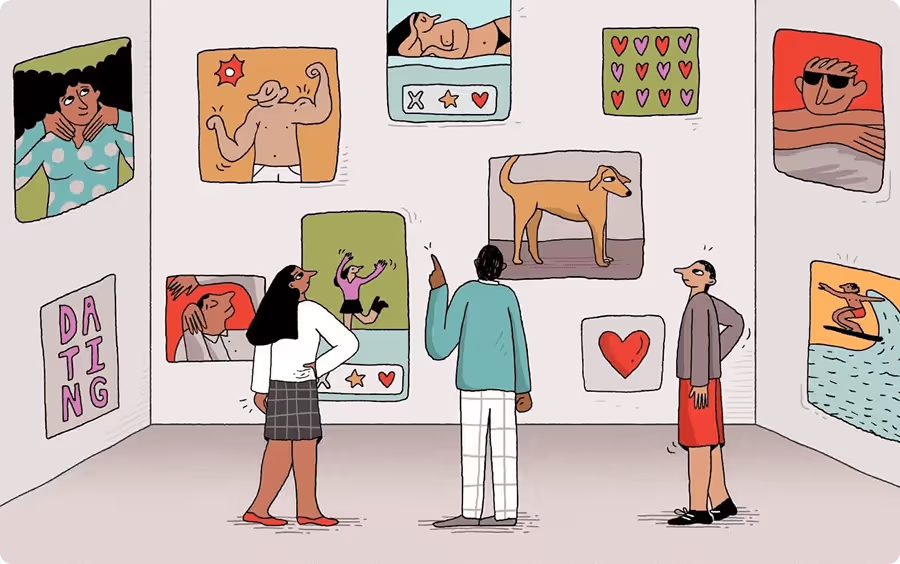Language shapes our lives before we even know how to speak it. Verbs such as “to begin,” “to grow,” and “to be” describe our entry into this world. Verbs such as “to grab,” “to smile,” and “to resist” aren’t far behind. Ideally, “to learn” and “to love” and “to be loved” fill our days from that point forward but we know these are the ones that carry the most complexity. We learn to love and to be loved from the responses of our caregivers. They form an internal compass that guides us—inward and outward, toward and away—often without our conscious knowledge.
Many of us spend our whole lives wondering why we engage with ourselves and each other in the ways we do. Some of us take quizzes to discover our attachment styles or our partners’ love languages. Some of us avoid the topic of intimacy entirely until a partner begs us “to open up” or “to show affection” or “to share what’s on our mind.” For those of us who struggle with intimacy, these verbs can feel daunting. But “love” itself is an active verb. It’s imbued with intention and meaning and contains an implicit call to action. “To love” contains infinite other verbs, such as “to care,” “to notice,” “to respond,” and the big ones usually reserved for wedding vows—“to have” and “to hold.”
It’s been said that we need fifty words in a foreign language in order to speak it. In the language of intimacy, basic fluency comes down to just seven verbs:
- to ask: How comfortable are you with asking? Some of us may think we know what feels good to us, what pleases us, what is meaningful to us, but we don’t feel entitled to these riches. Maybe we weren’t raised to feel we could ask. Alternatively, some of us have no problem asking for what we want and it might drive us crazy to have to guess at what our partner wants when it comes so easily to us.
- to take: While “to have” may be the verb at the root of desire, “to take” is at the heart of pleasure. When we allow ourselves to take pleasure in something, we permit ourselves to engage fully, to be immersed, to feel deserving, to experience healthy entitlement. In this mindset, we feel that we’re allowed to ask for attention and affection. For those of us who struggle with this, practice reframing phrases such as “I don’t want to take your time” to “may I take some of your time?”
- to receive: This is the most vulnerable verb of them all. It demands that we feel good about ourselves as is, that we acknowledge that someone can like and accept us, that they want to give to us and make us feel good. Receiving requires connecting with our senses of helplessness, exposure, and vulnerability more so than when we give. When we receive, we allow another to see us. We allow ourselves to be known. “To take” and “to receive” are not the same, but they are connected.
- to give: On the positive side, it’s appropriately giving gifts, time, attention, money, help. On the negative side, it’s what we do to avoid conflict. If we give everything, no one can expect anything.
- to share: Sharing comes from a sense of mutuality and reciprocity. If we grew up with an abundance mindset, sharing may feel totally natural. If we grew up with a scarcity mindset, or if we were raised in poverty, sharing may feel depriving and unfair or threatening to one’s safety.
- to refuse: Without a no, we can't develop a yes. But so many of us have a complicated relationship with our own right to refuse. Gabor Maté asks “what do you not say yes to that is as hurtful as what you don't say no to?” Where did we learn that if we say no there will be consequences? What is the story behind our experiences of saying “no”?
- to play: This is the verb connected to our creativity and problem-solving skills. To be able to play means that we feel safe enough to lift ourselves into our imaginative space. Diane Ackerman says “in deep play, we can lay aside our sense of self, shed time’s continuum, ignore pain, and sit quietly in the absolute present, watching the world’s ordinary miracles.” When we play, we can become any version of ourselves—the superhero or the villain or anyone in between.
These seven verbs are so effective at getting us started in the language of intimacy because they are some of the first ones we practice. Our understanding of intimacy as adults comes initially from our earliest experiences of these verbs. And behind each one are questions about how we learned to love and be loved:
- Did our caregivers monitor our needs or were we expected to monitor theirs?
- Did we learn we could trust others or not?
- Could we turn to our caregivers for protection or did we flee to protect ourselves?
- Were we held, rocked, or soothed or were our early days defined by rejection, humiliation, and abandonment? (Or all of the above, which can be just as confusing.)
- Did we learn not to expect too much?
- Was it okay to thrive?
- Did we learn to hide when we were upset?
- Did we learn to receive or to be denied?
- To dare or to be afraid?
- Was pleasure celebrated, suspiciously tolerated, or simply dismissed?
Part of this emotional scorecard is obvious, but much of it is often unspoken and concealed even from ourselves. It’s part of the diary that each person brings to the unknown continent of adult love. Having some language to describe the seemingly indescribable and undefinable helps us understand how we formed our expectations, conflicts, hope, and disillusionment with intimate connections.
The experiences that revolve around these seven verbs shape our beliefs about ourselves and our expectations of others. They influence how we conjugate so many of the other relational verbs: to meet, to listen, to desire, to seduce, to fuck, to rest, to fight, to fight back, to surrender, to console, to manipulate, to empathize, to violate, to protect, to lie, to omit, to admit, to hide, to abandon, to reconcile, to make love, to promise, to be together, to do better, to reveal, to learn, to grow, to change, to inspire…the list goes on for as long as we do and it varies in every relationship. Trace the lineage of any of these verbs and it will bring us back to the original seven.
Verbs are everything we do and everything we do to each other. We didn’t have a choice of how we learned them but we have some say in which ones we prioritize in our relationships with ourselves and each other. Challenging ourselves around the ones that are harder for us is an essential act of intimacy with ourselves. Every time we practice one of the verbs that we feel clunky about, we learn to give up some of the unhelpful coping strategies we developed that were once meant to protect us. It increases our vulnerability and our understanding of not just how we learned to love and be loved—but how we want to now.




.svg)





